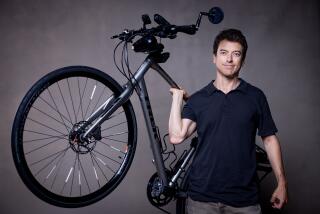Readers React: Why ‘road diets’ are exactly what we should be doing with gas tax money
To the editor: Motorists naturally complain when lanes dedicated for their near-exclusive use are replaced with bike lanes and other changes are made to improve safety. I ask them to look at the situation with a broader perspective. (“Using California gas tax to reduce traffic lanes? Not how it should be spent, some say,” May 27)
If we humans want to make it to the next century, we must take action now. This action must happen globally and at state and local governments, but even more important is support at the personal level.
With that in mind, motorists, instead of fuming about cyclists taking up “their” road, should rejoice at the sight of cyclists in the bike lane. Every one of them could be driving and taking up room in the car lanes, in addition emitting pollution and greenhouse gases.
Once drivers have acquired this positive mindset, their next logical thought should be whether they actually need to drive or if they could instead bike or, God forbid, walk.
I am 86 years old and rode my bike to work extensively. My cardiologist told me recently that I have clear arteries and a healthy heart. You don’t get that by sitting in traffic, fuming.
Paul Rosenberger, Manhattan Beach
..
To the editor: Road diets are a travesty regardless of how we pay for them.
Proponents of reducing road capacity invariably claim that lane reductions can be executed with little impact on traffic volumes. They can, but traffic volumes do not describe level of service. A given traffic volume can be achieved with denser, lower speed flow; or with sparser, higher speed flow.
Initiatives like Vision Zero focus worthy attention on pedestrian safety but deliver far too few safety improvements in exchange for potentially crushing increases in network travel delays. Lives have value. Time has value. Mobility has value. Vision Zero mismanages the trade-offs.
Put fuel tax revenues into capacity, maintenance, repair and congestion pricing tools.
James E. Moore II, Los Angeles
The writer is a professor in USC’s Viterbi School of Engineering and Price School of Public Policy and director of USC’s Transportation Engineering Program.
..
To the editor: We need to stop using the term “road diet.”
We are re-allocating the use of the pavement to accommodate bus lanes, bike lanes and pedestrians. Lanes are being re-allocated away from single-driver autos, a method of transportation responsible for L.A. sprawl and smog in the first place.
Plus, the gas tax hikes only make the math better for hybrids, electric vehicles, public transportation, biking and walking. We also need to consider the health benefits of biking and walking (when they can be made safe).
Win, win, win, I say.
Andrew Tilles, Studio City
Follow the Opinion section on Twitter @latimesopinion and Facebook
More to Read
A cure for the common opinion
Get thought-provoking perspectives with our weekly newsletter.
You may occasionally receive promotional content from the Los Angeles Times.










